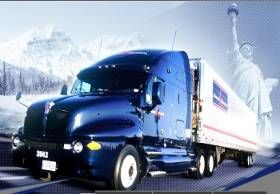New! High Road 2.0! We have a new version of this program. You can find it here: High Road 2.0
9.4 Loading and Unloading
General Loading Requirements
Do all you can to protect containers of hazardous materials. Do not use any tools that might damage containers or other packaging during loading. Do not use hooks.
- Before loading or unloading, set the parking brake. Make sure the vehicle will not move.
- Many products become more hazardous when exposed to heat. Load hazardous materials away from heat sources.
- Watch for signs of leaking or damaged containers: LEAKS SPELL TROUBLE! Do not transport leaking packages. Depending on the material, you, your truck and others could be in danger.
Packages secured in a vehicle:

Any package containing any hazardous material, not permanently attached to a motor vehicle, must be secured against movement, including relative motion between packages, within the vehicle on which it is being transported, under conditions normally incident to transportation. Packages having valves or other fittings must be loaded in a manner to minimize the likelihood of damage during transportation.
After loading, do not open any package during your trip. Never transfer hazardous materials from one package to another while in transit. You may empty a cargo tank, but do not empty any other package while it is on the vehicle.
No smoking:
When loading or unloading hazardous materials, keep fire away. Do not let people smoke nearby. Never smoke around:
- Class 1 explosives
- Division 2.1 flammable gas
- Class 3 flammable liquids
- Class 4 flammable solids
- Class 5 oxidizers
Cargo heater rules:
There are special cargo heater rules for loading:
- Class 1 explosives
- Division 2.1 flammable gas
- Class 3 flammable liquids
The rules usually forbid the use of cargo heaters, including automatic cargo heater/air conditioner units. Unless you have read all the related rules, do not load the above products in a cargo space that has a heater.
Use closed cargo space:
- Class 1 explosives
- Class 4 flammable solids
- Class 5 oxidizers
You must load these hazardous materials into a closed cargo space unless all packages are:
- Fire and water resistant, or
- Covered with a fire and water resistant tarp.
This short sentence has been known to show up on the written exam. You should never use hooks when loading hazardous materials.
Questions are frequently asked about smoking hazards. Make sure you memorize this list.
While not as common as questions about smoking, questions about cargo heaters will show up from time to time. Therefor, we recommend you memorize this list as well.









 TT On Facebook
TT On Facebook